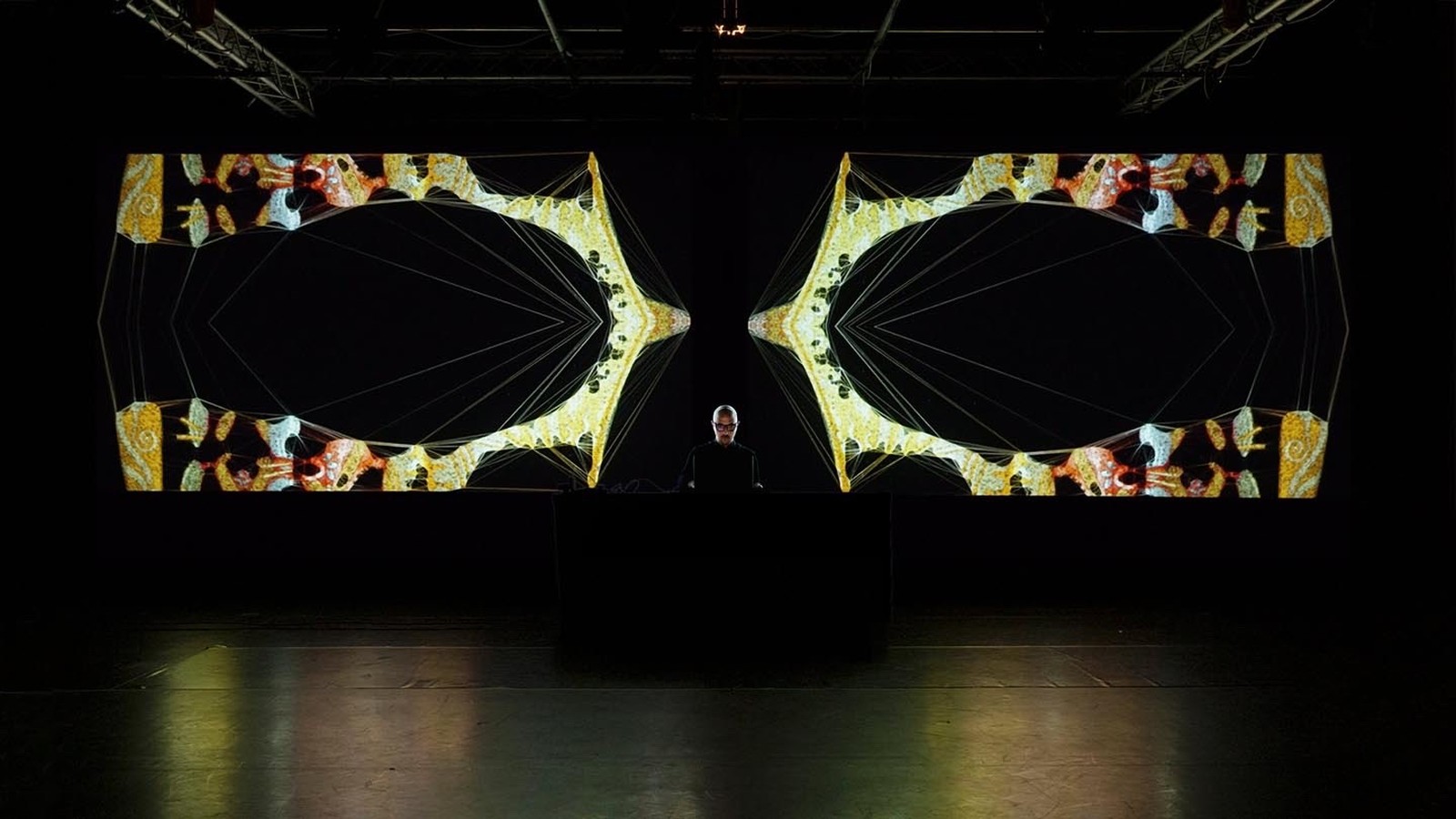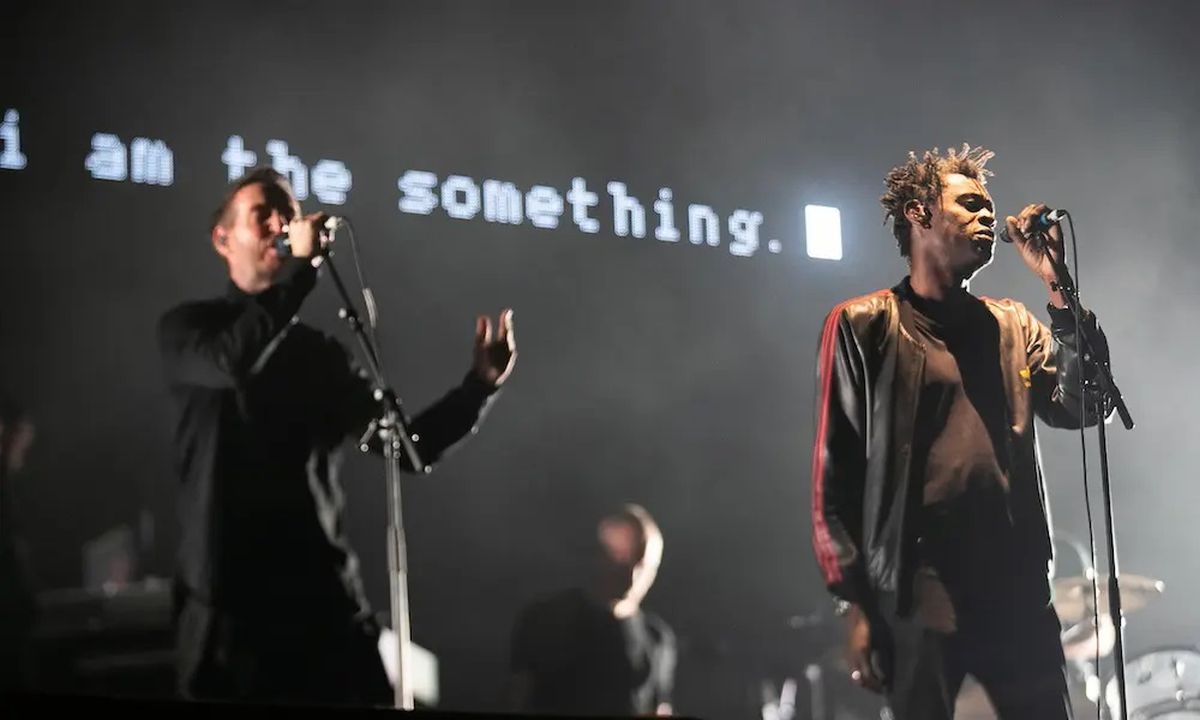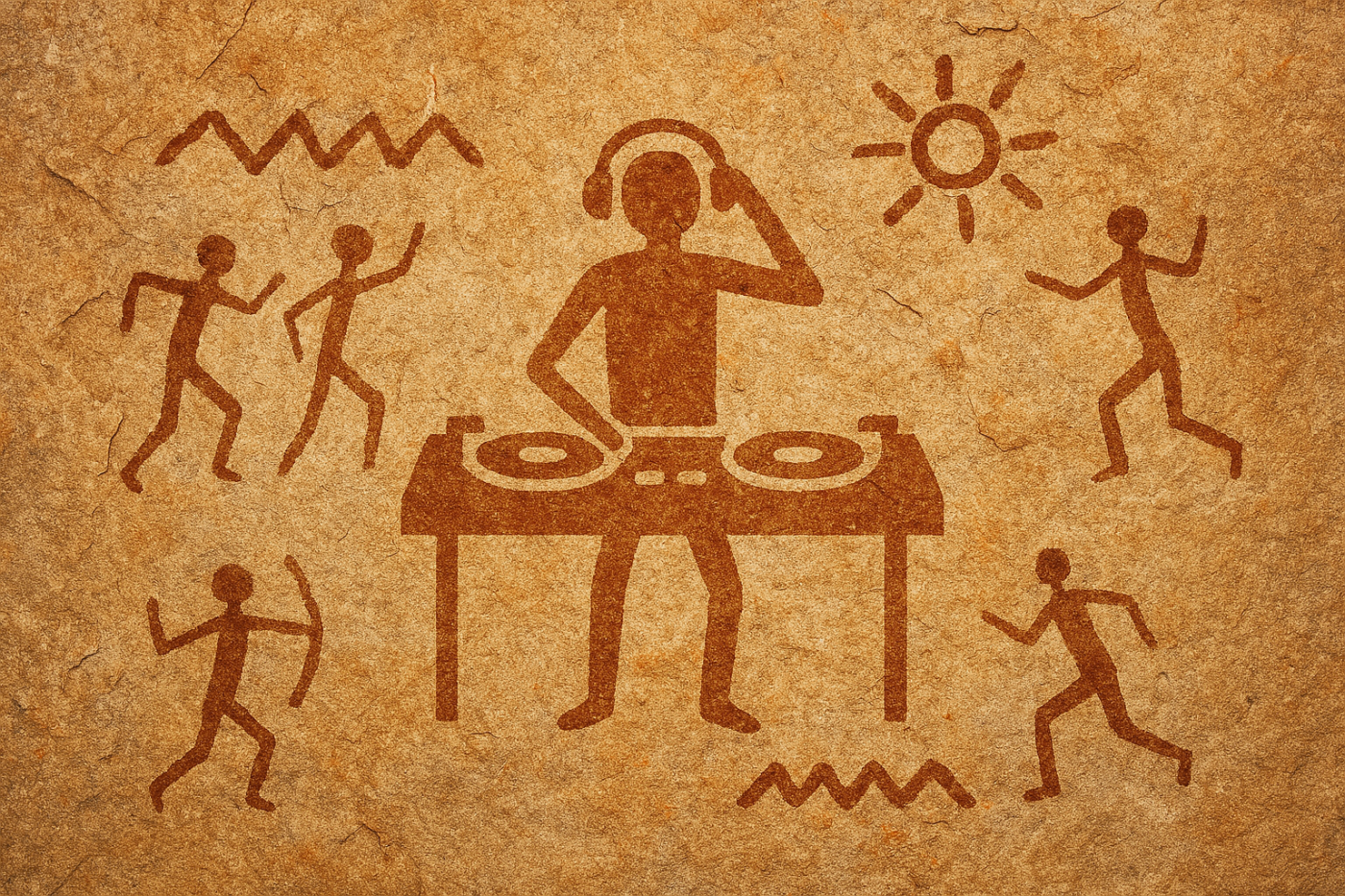From Fischinger to Giovinetto: one hundred years of audio-visual visions
With the performance FEMINA in collaboration with Factory Fest – October 11, 2025, Foligno
Introduction
Throughout the twentieth century, artists, scientists and musicians pursued a single dream: to make sound visible and image audible. This journey spans a century of experimentation — from abstract symphonies to generative performance — and now reaches a new chapter with Giovinetto, on stage in Foligno on October 11 with FEMINA, in collaboration with Factory Fest.
Origins: sound as form
It all begins in the 1920s and ’30s, when pioneers such as Oskar Fischinger and Mary Ellen Bute turned music into moving images. In their films, lines and circles behave like notes, anticipating the grammar of synaesthetic animation. At Canada’s National Film Board, Norman McLaren literally engraved sound onto film, generating optical vibrations that became music. A new language was born in which seeing and hearing exchanged roles: image did not illustrate music — it interpreted it.
Already Wassily Kandinsky, in writings such as Concerning the Spiritual in Art, had intuited a direct relationship between sound and colour — a correspondence between acoustic vibration and visual tension. His thought deeply influenced early pioneers of moving abstraction such as Fischinger and Bute, grounding the idea that every form can be “heard”.
The research of those years revolved around synaesthesia, understood as a perceptual shift between the senses. Not “seeing music” or “hearing colours” literally, but translating one sensory experience into another, searching for a shared language between sound and image. This idea would traverse the entire twentieth century, from abstract cinema to today’s immersive installations.
The 1960s: electronics becomes language
With the arrival of video, the image was no longer reproduced but generated. Nam June Paik, father of video art, built the Paik-Abe Synthesizer in 1969 — a machine capable of distorting and colouring television signals in response to sound. During his early performances, audiences accustomed to a stable TV image found themselves before waves and chromatic ripples behaving like magnetic currents — streams of light that seemed to expand and contract to the rhythm of the audio. Many viewers, letting go of narrative expectations, stood still for minutes, absorbed by this electric matter in transformation. Others described it as “hypnotic”, “closer to meditation than entertainment”. For the first time, television stopped broadcasting and started responding.
In the same period, Steina and Woody Vasulka turned electronic signals into plastic matter. In their experiments with oscilloscopes and tape machines, frequency became line and rhythm became light: figures deforming, doubling and dissolving in real time. Many critics called their work “electric landscapes”, an art of impulses rather than images.
In Italy, the tension between space and perception took shape. With works like Spazio Elastico (1967), Gianni Colombo built environments where audiences walked among luminous cords and moving walls: vision became physical experience. Ugo La Pietra worked on the interplay between individuals and the urban fabric, imagining “sensitive” spaces able to react to human presence. Entering those installations meant losing oneself in unstable perception, where the body ceased to be a spectator and became part of the device.
These experiments opened the way to a new understanding of A/V performance: not narrative, but sensory immersion.
The 1970s–’80s: feedback, computation and contemplation
In the 1970s and ’80s, the relationship between sound and image entered a decisive phase. The Vasulkas, pioneers of video feedback, built true image synthesizers: machines that translated sound into visual impulses and generated waves and light trails in real time. Eyewitnesses spoke of “landscapes without matter”, surfaces seeming to oscillate in space as if the gaze could touch sound.
At Bell and IBM labs, a new idea of the audio-visual artwork emerged: no longer gestural, but computed. Artists such as John Whitney, Lillian Schwartz and Laurie Spiegel began using computers as compositional tools. Frequently screened at experimental film festivals, Whitney presented spirals and figures rotating on musical ratios, inspiring wonder and puzzlement — some called it “mathematics that dances”.
Lillian Schwartz, collaborating with Bell Labs engineers, created films where computer-calculated forms intertwined with synthetic sound, leaving viewers unsure whether they were facing art or science. Laurie Spiegel composed sequences in which image and sound were generated by the same algorithm, suggesting that one day music and light would be programmed together.
Meanwhile, Brian Eno redefined perception itself. With ambient music and early light installations — seeds of 77 Million Paintings — he proposed experiences where sound became an environment and light its visual echo. Critics spoke of “soundscapes to inhabit”, inviting contemplation and extended listening.
The digital and the generative instant (1990s–2000s)
By the 1990s, the computer moved on stage. Modular software such as Max/MSP, Jitter and TouchDesigner enabled direct relations between audio signal and visual form. For the first time, the work was not edited but generated: each sonic variation could instantly transform the image.
This was the era of the audiovisual genre, in which sound no longer accompanied the visual — it created it. Artists like Ryoji Ikeda translated binary data into optical pulses (datamatics), building experiences oscillating between sensory perception and reflection on digital language. His work stages the tension between order and chaos: data becoming light, the bit turning into space.
Alongside these trajectories, artists such as Quayola and fuse* have pushed Italian research towards algorithmic and immersive visuality. In their works, data becomes a sensitive landscape and the machine a co-author: from Quayola’s stratified iconographies and architectural morphologies to the luminous dramaturgies of fuse*, code is not just a tool but a living matter capable of generating time, space and relation.
In parallel, Alva Noto sculpted silence. With minimalist sets he built architectures of glitches, impulses and voids — a fragmentary aesthetics where sonic form becomes visual structure, balancing control and interference. His dialogue with Ryuichi Sakamoto, also presented at Dancity, redefined the multimedia concert as a space shared between emotion and abstraction.
Robert Henke, co-founder of Ableton Live, shifted the focus to light as material. In works such as Lumière, lasers did not illustrate music; they built it — tracing lines, intervals and silence. Henke embodied a new figure: the composer-programmer writing with time and light.
Finally, Tarik Barri opened a spatial frontier. Through immersive architectures and collaborations with artists such as Monolake and Thom Yorke, he created real-time navigable environments in which the audience does not watch from the outside but enters the work. His performances mark the passage from representation to digital presence: an art to be traversed rather than contemplated.
From club culture to visual culture
Alongside more abstract research, the UK club scene opened a new front. Coldcut — pioneers of audiovisual intelligence and founders of the Hex collective — were among the first to turn the DJ set into a true A/V performance. With their software VJamm (early 1990s), they made it possible to play video like audio samples, anticipating modern VJing platforms by years. Their shows fused visual culture and electronic music into a synchronous flow of rhythm, images and message, carrying experimentation out of labs and into the club. A decisive turning point: the VJ became a performer, and remix culture found its first live audiovisual form.
Flying Lotus and the immersive spectacle
While conceptual research was defining its languages, other artists brought them towards pop culture. Among them Flying Lotus, whose 3D stereoscopic show became a pivotal moment — not for the visual effect alone, but for translating immersive A/V logics into an accessible narrative language. His presence at Dancity Festival marked an important chapter: an off-track perspective relative to academic research, yet perfectly coherent with the evolution of the A/V medium. Flying Lotus showed that experimentation can dialogue with pop without losing technical depth, bridging underground practice and large-scale spectacle.
Dancity milestones
Over the years, Dancity Festival has built a deep relationship with audio-visual arts. From the minimalist architectures of Alva Noto & Ryuichi Sakamoto (2011) to the intensity of Ryoji Ikeda, from Robert Henke’s laser explorations to Tarik Barri’s navigable spaces, the festival has consistently explored dialogues between sound, image and perception.
Among the most poetic moments, in 2012 Dancity also hosted the Quiet Ensemble with their installation Natura Morta (Still Life) — a work intertwining technology, chance and nature. Sounds and lights were generated by living and unpredictable elements — plants, fruits, water, electricity — reminding us that even error can become composition, and that the audiovisual realm is, above all, an ecosystem.
Equally meaningful was the performance by Murcof & Vanessa Wagner (2014), where piano and electronics reshaped acoustic space as living matter. And the visual poetry of Ryoichi Kurokawa, fusing digital rendering and contemplative pacing, became one of the most immersive experiences ever presented in Foligno: works where sound crystallises into light and light becomes time.
Ei Wada brought cathode-ray televisions back to life, turning them into musical instruments. Through direct contact with hands and body, he modulated electromagnetic fields to generate tuned and percussive sounds, as if the skin itself were a sensor. Halfway between art and play, the experience captivated everyone — from experimental die-hards to the simply curious, children included — proving that A/V language can be at once profound and accessible, embodied and collective.
Giovinetto: between science and perception
Trained as a physicist, composer and visual artist, Riccardo Giovinetto works from a simple, radical premise: every sound carries a form. After years in the duo OZMOTIC — with releases on Touch alongside Fennesz and Biosphere — Giovinetto embarked on a solo path that fuses mathematical rigour and poetic intensity.
In FEMINA, presented at Ars Electronica, body and voice become sources of frequency. Light does not illustrate music; it is its visible consequence: a responsive environment in which each variation generates a form and each breath reshapes space.
The result is a reflection on identity and presence: an art that treats sound as living matter in continuous transformation.
Dancity × Factory Fest: a new chapter
With Giovinetto and the collaboration with Factory Fest, Dancity renews its interdisciplinary vocation. This is not merely about hosting a show, but about joining a living history that began almost a century ago — a story that keeps inviting us to listen with open eyes.
🎥 Videos & insights
- Steina & Woody Vasulka – Electronic Art
- Ryoji Ikeda – datamatics
- Alva Noto & Ryuichi Sakamoto – Live @ Dancity 2011
- Robert Henke – Lumière
- Tarik Barri – Monolake live visuals
- Ryoichi Kurokawa – unfold
- Flying Lotus – 3D Show at Dancity, Spoleto (IT)
Event Information
FEMINA – Audiovisual Performance by Riccardo Giovinetto
Presented in collaboration with Factory Fest · October 11, 2025 · Foligno
🎟️ Tickets: Buy on DIY Ticket
📩 Reservations & inquiries: factoryfest.tickets@gmail.com · WhatsApp +39 389 0231912
Our project is independent and non-profit.
If you enjoy what we do, you can support us with a small donation.




